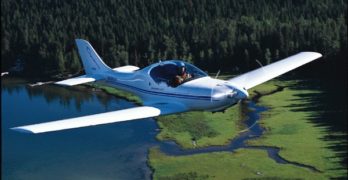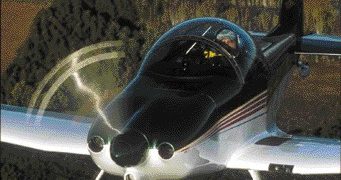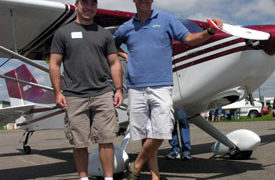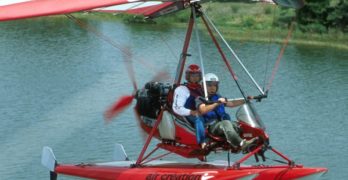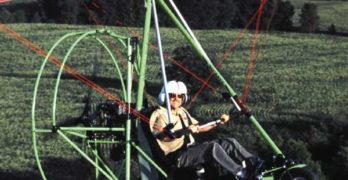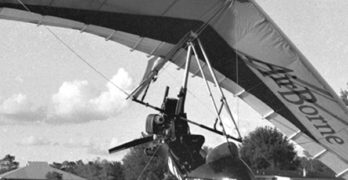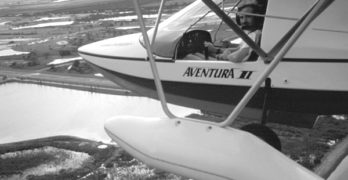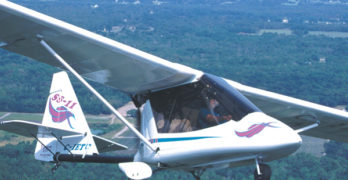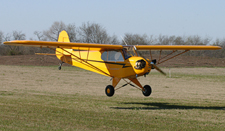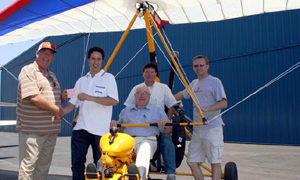While many American pilots focus on SportPlanes™/ light-sport aircraft (LSA), sales of amateur-built kits continue. As the government crawls toward release of the new rule, the WT-9 Dynamic from Aerospool is one that might go both ways.
You might choose a fixed-gear, Rotax 912 80-hp model that U.S. importer Dan Defelici believes may meet the proposed regulation. But today you can buy a retractable Dynamic and build and fly the speedster around the U.S. under the 51% rule. Since LSA will probably not allow retractable landing gear, flying a retractable WT-9 will require more than a Sport Pilot license.
Getting Some Help
The 51% rule intends that the owner of a kit airplane should build more than half of the plane. The FAA has created extensive checklists to assure that a wide variety of kits meet this rule. Factories often do the hard parts that require jigs and other special equipment.
Search Results for : Flight Design
Not finding exactly what you expected? Try our advanced search option.
Select a manufacturer to go straight to all our content about that manufacturer.
Select an aircraft model to go straight to all our content about that model.
World’s Fastest Mustang II?
When most of us think about a fast airplane, we sketch in our minds a sleek and smooth exterior and wings that allow the graceful machine to slip through the air with the least possible resistance. We think the engine is also important and that more power is better than less.
But according to race winner Brian Schmidtbauer, up to 30% of the total drag in an aircraft can be cooling drag, or air movement through the engine compartment.
Because I often review gliders and slower powered aircraft, I’m sure I displayed a slack-jawed response to this comment. The stunned expression stayed on my face as Schmidtbauer described detail after detail about the handling of cooling air.
After an hour-long flight in his blazing Mustang II, I came away a believer. His homebuilt aircraft has beaten the likes of jet-smooth Lancairs and isn’t threatened by speedy RVs. In fact, only his buddy and RV-4 pilot Dave Anders has beaten Schmidtbauer in a race, and they’re so close that the next race might be different.
RANS Plans for New SLSA to Go High & Low
At the Minneapolis Sport Pilot Tour, RANS exhibited their S-6 and S-7LS. At a fly away price of $75,000 S-7LS Courier SLSA represents a strong value. Coyote S-6 remains a 51% kit, one of the most popular in the world. Either can be flown with a Sport Pilot Certificate. Earlier this year the Hays, Kansas company abbreviated their line to their best sellers (S-6, S-7 & S-12) *** New Light Sport Aircraft from RANS are still in development. Designer Randy Schlitter has already announced his low-wing S-19, but he told me of S-20, a high wing variation using many of the same components. This could smartly establish RANS against Euro designs like Italy’s Tecnam with their high wing Bravo and low wing Sierra, which also share components. Look at the entire RANS family of planes. (The RANS website has no info on S-20 yet.)
Air Création’s High-Performance Floats
Air Création is a serious company and a world-class trike builder with an impressive sales record. Their serious trikes sport beautiful hardware and numerous customized components. Right down to their trademark red color, Air Création is serious about building a remarkable trike, a series of them in fact.
So when Air Création puts a float set on the market, you can count on the fact that it was well researched and exquisitely crafted.
Now, let’s combine that with the XP-17 wing, the largest in the company’s XP series. Floats are mounted under and the wing atop a GTE trike carriage which has been in production for several years. Put this all on a lake in Florida and you have the makings of an interesting experience.
Another 20-Year Veteran
Gilles Bru and Jean Yves le Bihan founded the French company in 1982. Air Création’s dealer in Canada reports, “It has grown steadily ever since, building around 4,000 wings and 2,500 trike-units for sale in more than 50 countries.”
Today Air Créationemploys 25 people, four of whom are in the technical department designing new products, and 14 work on the production of ultralight trikes and wings.With annual sales of about $2.5 million, Air Création exports 60% of its products.
Buckeye Convertible
I never really noticed before just how much the Buckeye Industries powered parachute carriage looked like a trike carriage. Maybe you didn’t either, but in your mind’s eye, remove the prop guard and see if you don’t agree. They aren’t identical, of course, but the visual relationship is uncannily close considering the two aircraft types developed separately.
What a perfect situation. Ralph Howard’s family members and friends have built Buckeye from “nothing” to one of the world’s largest aircraft manufacturers, all in the ’90s and without even using the entire decade! Whatever combination of talent, money, timing and luck was involved in this tale of success, the Howards want to keep it going strong. That won’t be easy, but these Indiana Hoosiers may be up to the task.
Take the momentum of a reported several hundred powered parachute units sold each of the last few years. Revise the hardware slightly to expand into the manufacture of trikes, and you have a potent mixture that could emerge as one of America’s largest trike builders.
The AirBorne Edge
AirBorne Windsports is no johnny-come-lately to the ultralight flying scene. The Australian company has been making hang gliders for the international market for years. AirBorne’s owners – Russ and Rick Duncan – once flew for Moyes Delta Pty., another Australian hang glider company (now known for its Moyes-Bailey Dragonfly aerotug), but later branched out on their own.
While both men are thirty-somethings today, they have long experience, starting with competition in hang gliders back when folks still called them “the little Duncan brothers.” They were hot pilots at a young age. Later on, they proved to be solid competitors to the Moyes juggernaut.
Then Came Trikes
A divergence occurred. After linking up with Florida designer Bobby Bailey to produce the 3-axis Dragonfly aerotug, Moyes’s interest in trikes fell by the wayside. They focused on the already popular Dragonfly for their towing promotion.
Meanwhile, the Duncans – now on their own, producing hang gliders – engaged in building trikes.
Aventura II
If you’ve never flown an airplane on floats, you’ve missed a glorious experience in flying. Good as any ultralight on floats may be – and that means “quite excellent” in my opinion – even those pilots with that experience may have missed the unique sensation of a boat-hulled ultralight.
With a few thousand hours in my logbook covering everything from foot-launched hang gliders to twin-engined Barons, I can honestly say my absolute favorite hours are spent in one of two ways: first is soaring flight, but a close second is warm summer day flying in an ultralight floatplane.
It just doesn’t get any better.
Having stuck my personal opinion into this article, I must tell you about a most promising company and their 2-seat floatplane, the Aventura II. Since Arnet Pereyra exploded into the ultralight scene in 1995, this new company has filled out their line of floatplanes with a roomy and fun 2-seater which deserves a close look.
Eye On the Sky Watch
There was a time when a company called Beaver RX Enterprises – which produced the Canadian Beaver designs – was among the leading North American ultralight manufacturers.
In particular, the Beaver 550 tandem 2-seater attracted many customers. The company once claimed more than 3,500 ultralights flying. Certainly the model dominated the western Canadian market but also had a presence in the U.S. and other countries.
The old Beaver RX Enterprises company went through a number of leadership changes and, driven by overly-ambitious management goals, finally succumbed.
When I visited the now defunct company, the firm was a publicly-held corporation listed on the Vancouver Stock Exchange. Even the stock exchange has experienced a transformation, so perhaps it isn’t surprising that Beaver RX Enterprises also lost its heading.
As we’ve seen with other good designs, however – such as Quicksilvers, Phantoms or Drifters – the better ultralights can outlast their ownership. The Beaver line is among those survivors.
A Legend Makes An Appearance
As a new season of flying for fun starts the Legend Cub from Sulphur Springs, Texas made its first flight. Company founders Tim Elliott and Darin Hart say their new Cub lookalike (it isn’t identical, for example, it’s got a wider cockpit) is for “recreational flyers of all ages around the world.” That’s a big statement but the popular design shape is certain to find good appeal. The Legend Cub makes its public debut at Sun ‘n Fun 2005. Look for a pilot report in an upcoming EAA Sport Pilot magazine.
World-Traveling Trike Wins SLSA Approval (#38)
Matt Liknaitzky, the U.S. importer for the French-designed DTA weight-shift aircraft is the newest winner of an Airworthiness Certificate for this world-spanning trike. A DTA Voyageur was used in a spectacular 1999 flight from the tip of South America through the USA across the Atlantic and back down through Europe to South Africa. This immense 26,703-mile cross country trip was accomplished by Mike Blyth and Olivier Aubert and was beautifully documented on a DVD video called “South to South.” The very tough Rotax 912-powered DTA trike is distinguished by its structural mast that makes a forward support tube unnecessary, thereby improving visibility. *** Matt is also the importer of a line of electronic flight instruments under the brand name Stratomaster. I’ve flown with them and loved their clean, clear display. His business, Sport Flying Shop, also carries a wide variety of other flying gear, and is based at the Torrence, California airport.
- « Previous Page
- 1
- …
- 119
- 120
- 121
- 122
- 123
- …
- 147
- Next Page »


